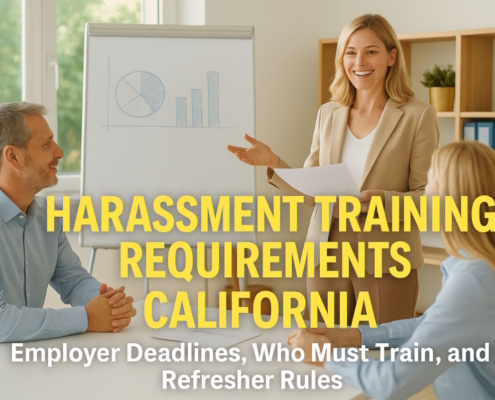Introduction
Workplace harassment is a severe problem. It might be sexual misconduct or harassment due to some other covered trait. Does your company provide the mandatory harassment prevention training? You will require fresh training of your staff in 2025, in case you trained them in 2023. Many employers still misunderstand the Harassment Training Requirements in California. It often leads to compliance mistakes.
Harassment Training Requirements in California
All employers with five or more employees are subject to California’s harassment prevention training regulations. Both supervisors & nonsupervisory staff are required to go through harassment prevention training. Supervisors must do so for two hours, and nonsupervisory staff must do so for one hour.
All personnel must undergo training within 6 months of being hired or promoted. They must thereafter undergo retraining every two years. Temporary and seasonal workers, as well as those hired for fewer than six months, are required to get training within thirty working days of employment or within one hundred hours of work, whichever comes first. These timelines are part of the Harassment Training Requirements in California.
As an employer, you can be held liable for the activities of the managers and employees. The issue of preventing or stopping sexual harassment requires understanding what sexual harassment and other forms of harassment mean as they are defined in the federal and California legislation.
Many businesses violate the Harassment Training Requirements in California because they fail to train newly hired temporary workers on time.
Common Mistakes
- Failing to train employees who work off-site in California.
- Failing to continue training after two years.
Such errors typically occur because employers misunderstand the Harassment Training Requirements in California.
Workplace Harassment Explanation
Sexual harassment is an unlawful form of conduct in the workplace. It is either verbal, visual, or physical. It may be driven by the gender of a person, their sexual orientation, gender identity, or gender expression. Other types of illegal workplace harassment also exist.
State and federal harassment statutes have varying liability ramifications. It’s vital to understand how they differ.
1. Federal Law
The seventh title of the Civil Rights Act of 1964 prohibits harassment in the workplace. Businesses that employ 15 or more people every working day in at least twenty calendar weeks during the current or previous calendar year are covered by Title VII.
2. State Law
California Fair Employment & Housing Act outlaws unlawful workplace harassment. FEHA also prohibits workplace harassment of unpaid trainees, volunteers, & independent contractors.
There are numerous more protected classes in the state of California, in addition to discrimination based on sex.
- Color and Race (includes hair texture and hairstyle);
- Ancestry and national origin;
- Status of marriage;
- Disability (both physical & mental, including HIV, AIDS, and pregnancy);
- Age (above 40);
- Medical condition (including hereditary traits and cancer);
- Making decisions on reproductive health;
- Genetic data; and
- Military or veteran status.
Sexual Harassment Categories
Unwelcome remarks or actions related to sex that are considered either severe or widespread enough to unjustly interfere with a worker’s capacity to perform their job are referred to as hostile work environment harassment. They create an unpleasant, hostile, or insulting work environment that changes the terms of employment.
Quid Pro Quo Sexual harassment happens when a candidate or employee is required to submit to sexual approaches or other sex-based behavior to be hired or promoted, either overtly or implicitly.
Preventing Workplace Harassment
Customers, vendors, coworkers, & supervisors are all covered by harassment laws. You and your workers may be held accountable for your conduct or inaction.
Harassment related to any protected class is illegal under both state and federal law. It is also seen as discrimination, although sexual harassment receives maximum attention and coverage. One is not allowed to harass a person due to their age, color, country of origin, impairment, or religion.
Workplace Harassment Training Requirements in California
Every two years, firms in California with five or more employees—including those who operate outside the state—must give harassment awareness training to every employee in California. Two full hours of training are needed for supervisors, and one hour is required for all other staff. Training is required even for seasonal and temporary workers. Both the avoidance of abusive behavior and harassment based on sexual orientation, gender identity, and gender expression must be covered in training.
Obligation to Prevent
Every employer has to take precautions & steps against harassment in the workplace. They must act quickly to address it when it does occur.
Employers in California are required by law to provide their staff with a documented policy that prohibits discrimination, harassment, & retaliation. California law requires the policy to adhere to a number of stringent conditions.
Employers in California must also:
- Post the Civil Rights Department’s mandatory notices; and
- At the time of hiring, give a sexual harassment awareness leaflet to every employee.
These steps must be completed as part of the Harassment Training Requirements in California.































